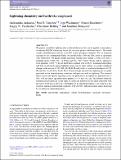Lightning chemistry on Earth-like exoplanets
Abstract
We present a model for lightning shock-induced chemistry that can be applied to atmospheres of arbitrary H/C/N/O chemistry, hence for extrasolar planets and brown dwarfs. The model couples hydrodynamics and the STAND2015 kinetic gas-phase chemistry. For an exoplanet analogue to the contemporary Earth, our model predicts NO and NO2 yields in agreement with observation. We predict height-dependent mixing ratios during a storm soon after a lightning shock of NO ≈ 10-3 at 40 km and NO2 ≈ 10-4 below 40 km, with O3 reduced to trace quantities (≪10-10). For an Earth-like exoplanet with a CO2/N2 dominated atmosphere and with an extremely intense lightning storm over its entire surface, we predict significant changes in the amount of NO, NO2, O3, H2O, H2 and predict a significant abundance of C2N. We find that, for the Early Earth, O2 is formed in large quantities by lightning but is rapidly processed by the photochemistry, consistent with previous work on lightning. The chemical effect of persistent global lightning storms are predicted to be significant, primarily due to NO2, with the largest spectral features present at ∼3.4 and ∼6.2 μm. The features within the transmission spectrum are on the order of 1 ppm and therefore are not likely detectable with the James Webb Space Telescope. Depending on its spectral properties, C2N could be a key tracer for lightning on Earth-like exoplanets with a N2/CO2 bulk atmosphere, unless destroyed by yet unknown chemical reactions.
Citation
Ardaseva , A , Rimmer , P B , Waldmann , I , Rocchetto , M , Yurchenko , S N , Helling , C & Tennyson , J 2017 , ' Lightning chemistry on Earth-like exoplanets ' , Monthly Notices of the Royal Astronomical Society , vol. 470 , no. 1 , stx1012 , pp. 187-196 . https://doi.org/10.1093/mnras/stx1012
Publication
Monthly Notices of the Royal Astronomical Society
Status
Peer reviewed
ISSN
0035-8711Type
Journal article
Description
AA, PBR and ChH gratefully acknowledge the support of the ERC Starting Grant no. 257431. IW, MR, SNY and JT also gratefully acknowledge the support of the STFC (ST/K502406/1), and the ERC projects ExoMol (26719) and ExoLights (617119).Collections
Items in the St Andrews Research Repository are protected by copyright, with all rights reserved, unless otherwise indicated.

